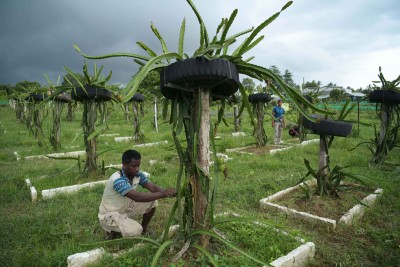April 01, 2025 06:59 am (IST)

Scientists in UN-backed initiative decode tsetse fly genome
New York, Apr 25 (IBNS): Scientists in a United Nations-backed collaborative have cracked the genetic code of the bloodsucking tsetse fly in a breakthrough that brings new hope to the fight against one of the most devastating livestock diseases spread by the insect.
Tsetse flies are vectors for the single-cell parasites that cause trypanosomiasis, or nagana, an often-lethal disease that affects some 3 million animals in sub-Saharan Africa each year at massive costs to farmers’ livelihoods and food security.
The tsetse genome was sequenced and annotated during a 10-year global collaborative effort that involved the Insect Pest Control Laboratory run jointly by the Rome-based UN Food and Agriculture Organization (FAO) and the International Atomic Energy Agency (IAEA) in Vienna.
Scientists will now be able to better study the fly’s genes and functions, knowledge that should open the door for researching ways to control the insect, according to a news release issued by the two UN agencies.
“Decoding the tsetse fly’s DNA is a major scientific breakthrough that opens the way for more effective control of trypanosomiasis, which is good news for millions of herders and farmers in sub-Saharan Africa,” said Kostas Bourtzis of the Joint FAO/IAEA Division of Nuclear Techniques in Food and Agriculture.
“Detection and treatment of trypanosomiasis is currently expensive, difficult and dangerous for the livestock as it often involves toxic drugs, but this new knowledge will accelerate research on tsetse control methods and help scientists develop new and complementary strategies to reduce the use of costly drugs and insecticides,” he said.
Trypanosomiasis leads to a debilitating chronic condition that reduces fertility, weight gain, meat and milk production, and makes livestock too weak to be used for ploughing or transport, which in turn affects crop production.
Humans bitten by carrier flies can develop African sleeping sickness, which can be fatal without treatment.
No vaccine against the disease exists for livestock or humans because the parasite is able to evade mammalian immune systems, so control methods primarily involve targeting tsetse flies through trapping, pesticide treatments and sterile male release strategies.
The Joint FAO/IAEA Division is currently supporting 14 African nations in their efforts to tackle the trypanosomiasis problem by controlling tsetse fly populations by integrating the sterile insect technique with other control methods.
A form of “insect birth control,” according to the Division, the sterile insect technique involves releasing mass-bred male flies that have been sterilized by low doses of radiation into infested areas, where they mate with wild females. These do not produce offspring and, as a result, the technique can suppress and, if applied systematically on an area-wide basis, eventually eradicate populations of wild flies.
Tsetse flies were successfully eradicated from the island of Zanzibar using the sterile insect technique and are currently being suppressed in parts of southern Ethiopia. In January, Senegal reported that it was making significant progress in infested areas in the Niayes with the same method.
(A bite from a parasite-carrying tsetse fly can cause trypanosomiasis in animals and sleeping sickness in humans. Photo: Geoffrey M. Attardo, Research Scientist, Yale School of Public Health)
Support Our Journalism
We cannot do without you.. your contribution supports unbiased journalism
IBNS is not driven by any ism- not wokeism, not racism, not skewed secularism, not hyper right-wing or left liberal ideals, nor by any hardline religious beliefs or hyper nationalism. We want to serve you good old objective news, as they are. We do not judge or preach. We let people decide for themselves. We only try to present factual and well-sourced news.
Support objective journalism for a small contribution.
Latest Headlines
Health workers call for cleaner air to reduce pollution deaths, halve its deadly impacts by 2040
Sat, Mar 29 2025
Indo-British Scholars Association hosts 'Celebrating Life with Cancer Survivors' for Tata Medical Center patients in Kolkata
Wed, Mar 26 2025
New Delhi: AIIMS to install first indigenously-developed magnetic resonance imaging machine in October
Wed, Mar 26 2025
Indo-British Scholars Association hosts 'Celebrating Life with Cancer Survivors' for Tata Medical Center patients in Kolkata
Wed, Mar 26 2025
West Bengal: Indian Army conducts eye surgical camp at 158 Base Hospital in Bagdogra, 350 cataract surgeries performed
Mon, Mar 24 2025
Detect Early, Protect Kidney Health
Wed, Mar 12 2025
Funding cuts jeopardise global fight against tuberculosis, WHO warns
Fri, Mar 07 2025
More than half of adults worldwide will be obese by 2050: Study
Tue, Mar 04 2025







